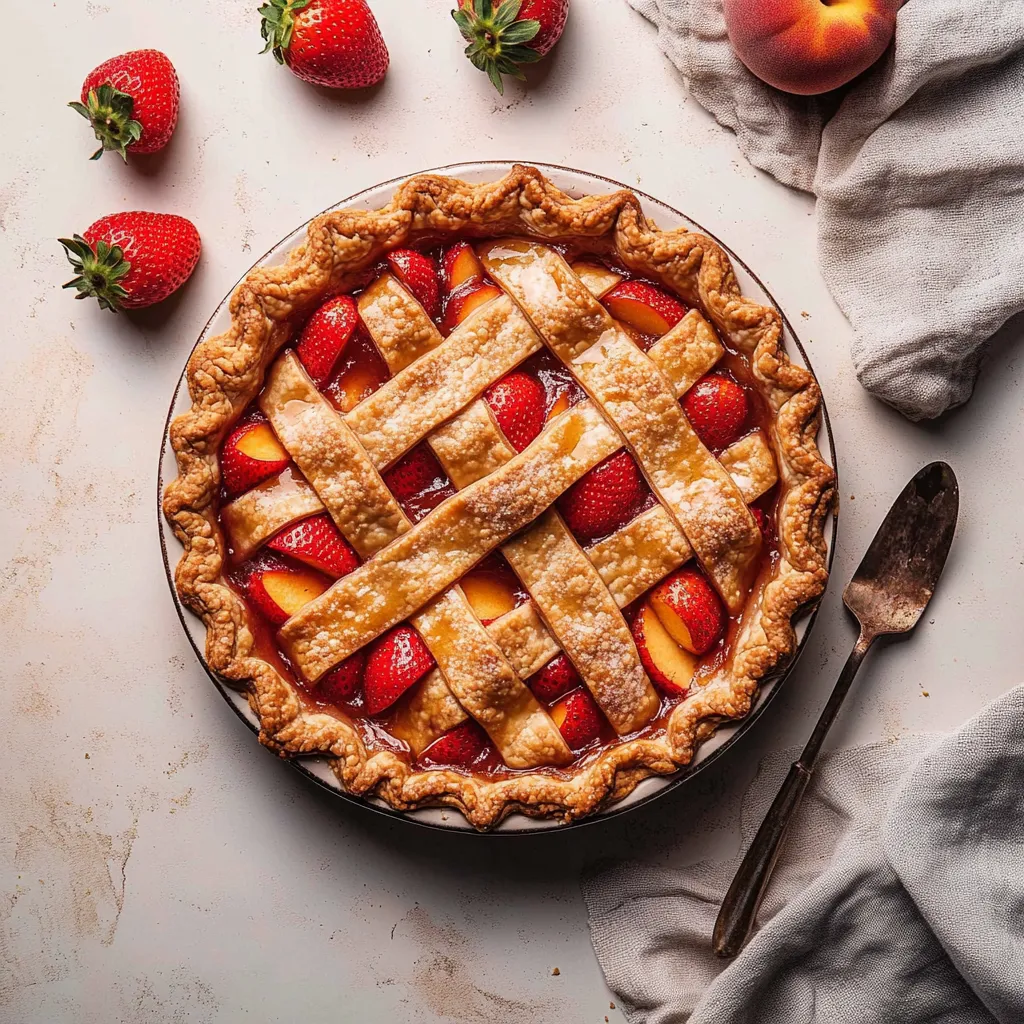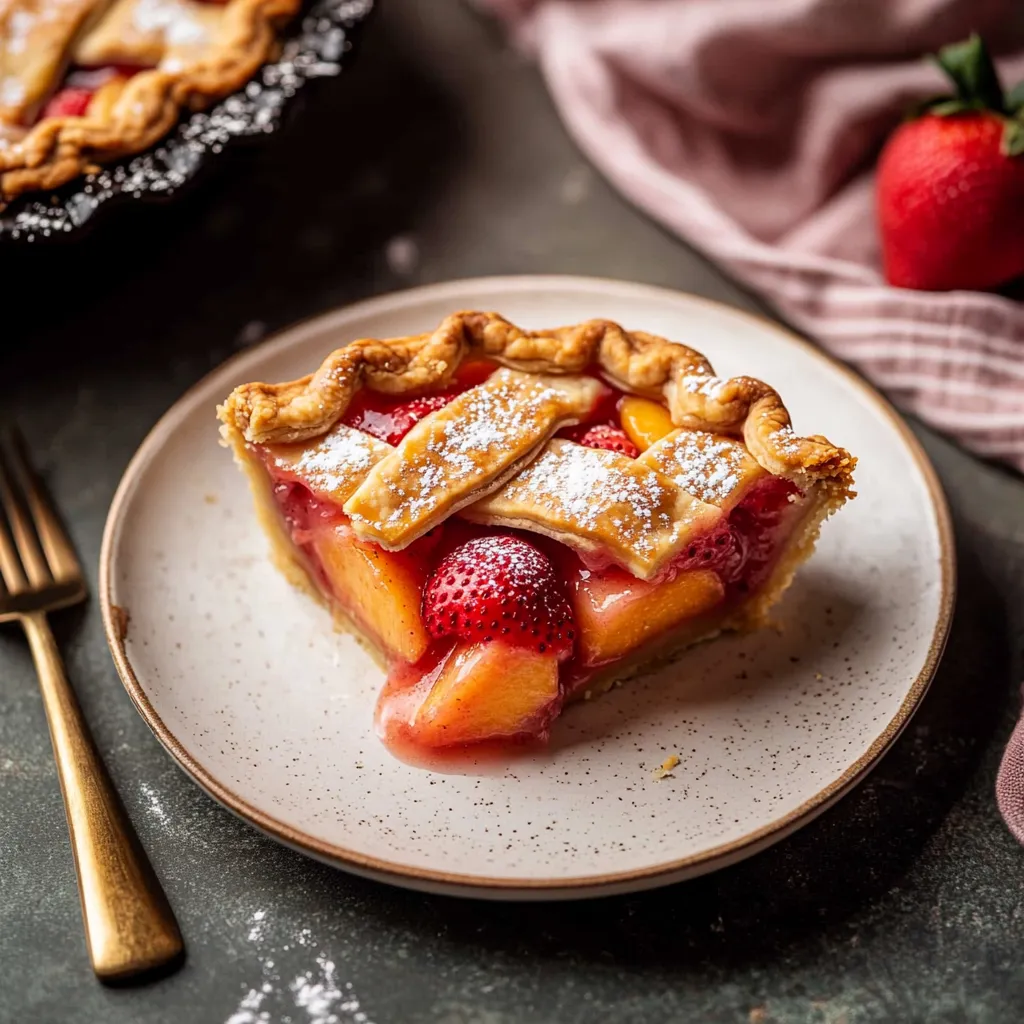 Pin it
Pin it
This nutty brown butter pie blends toasty richness with bright summer fruit flavors. The flaky, buttery crust wraps around juicy peaches and tangy strawberries, creating a treat that's fancy yet feels like home cooking.
I whipped this up for a backyard gathering once and couldn't believe how many folks came back for more helpings. That brown butter trick turns an everyday fruit pie into something people can't stop talking about—and it hardly takes any extra work.
What You'll Need
- Cold unsalted butter: This gets browned for that nutty flavor boost. Grab the good stuff for best results.
- All purpose flour: Gives your crust the right texture. Spoon it into your cups and level off for the right amount.
- Fine sea salt: Brings out all the tasty bits in both crust and filling. Skip regular table salt as it can taste funny.
- Apple cider or white vinegar: Keeps your dough tender by fighting gluten buildup.
- Fresh peaches: Look for ones that feel ripe but still firm when you give them a gentle squeeze.
- Fresh strawberries: Go for completely red ones without any white tops for the sweetest flavor.
- Cornstarch: Stops your filling from turning into soup. Don't skimp or you'll have a drippy mess.
- Lemon juice and zest: Adds a zippy kick that balances the sweetness.
- Turbinado sugar: Not required but worth adding for that sweet crackly top.
How To Make It
- Get that butter browned:
- Put your butter in a metal pan over medium heat. Let it cook 10–12 minutes until the bits turn golden and it smells nutty and delicious. You'll see it foam up before settling down as water cooks off. Watch it like a hawk since it can burn in seconds. Take it off the heat as soon as it's done.
- Make it solid again:
- Put parchment in a shallow dish and pour in your browned butter, making sure to scrape out all those tasty brown bits. Stick it in the freezer until it's hard, about an hour. You can't skip this if you want those flaky layers.
- Mix your dough:
- Cut your frozen brown butter into tiny cubes and pop them back in the freezer. Using your stand mixer, blend flour and salt. Add the frozen butter chunks and mix on low until it looks like sandy mix with some pea-sized butter bits left, around 3 minutes. Those little butter pieces are what make your crust flaky.
- Add cold water:
- Mix water and vinegar in a cup with ice. While your mixer's running on low, add this icy mix one spoonful at a time until the dough starts clumping around the paddle. It should feel damp but not sticky. Don't mix too much or your crust won't be flaky.
- Let it rest:
- Split the dough into two equal parts, about 335 grams each. Wrap them up and flatten into discs. Put them in the fridge for at least an hour. This helps the dough relax and lets moisture spread evenly.
- Roll out the bottom:
- Take one disc and roll it on a lightly floured counter. Roll from the middle outward, turning it often so it doesn't stick. Aim for a 12-inch circle about 1/8 inch thick. Put it in a 9-inch metal pie dish and stick it back in the fridge while you work on the top.
- Make your lattice strips:
- Roll the other disc to the same thickness. Cut it into 1-inch strips for your lattice. Put these on a parchment-lined baking sheet in the fridge while you make the filling. Cold dough is the secret to flakiness.
- Mix your filling:
- Toss sliced peaches, cut strawberries, sugar, cornstarch, lemon juice, zest, and salt in a big bowl. Mix gently but thoroughly so the cornstarch coats everything. Pour this into your chilled crust, leaving extra juice behind.
- Create your lattice pattern:
- Lay strips across the pie going one way. Fold back every other strip halfway, place a strip going the other direction, then fold the strips back down. Keep going with this pattern until you've woven the whole top. Trim the extra dough and tuck edges under the bottom crust.
- Bake it up:
- Pinch the edges into a pretty pattern. Brush the lattice with egg wash and sprinkle with turbinado sugar. Put the pie on a baking sheet with sides. Bake at 425°F for 25 minutes, then turn it down to 350°F without opening the oven and bake another 40–50 minutes until golden brown and bubbly. Cover with foil if it gets too dark.
 Pin it
Pin it
The brown butter really makes this pie stand out from the crowd. I tried it years ago and can't imagine going back to regular pie crust now. Those rich, toasty notes work so well with the sweet fruits, and everyone always asks me what my secret is. My little girl now wants this instead of birthday cake every summer.
Choosing Your Fruits
Getting the right fruit really matters for this pie. Your peaches should be ripe but still a bit firm so they don't turn mushy when baked. Too soft and they'll just melt away and make everything soggy. For strawberries, look for ones that are red all the way through with a sweet smell. Don't use berries with white tops or empty middles since they won't have much flavor. If your peaches aren't quite ripe yet, stick them in a paper bag at room temp for a day or two to speed things up.
Prep It Early
This pie actually tastes better when you make it ahead of time. The flavors mix together wonderfully as it sits, and letting it cool all the way helps the filling set up just right. You can make the dough up to 3 days before and keep it in the fridge, or freeze it for up to 3 months. You can even freeze the whole unbaked pie for up to 3 months. When you're ready to bake a frozen pie, don't thaw it first—just add about 20–25 extra minutes to the baking time, starting with a cold oven.
What To Serve With It
This pie tastes great by itself, but adding the right sides makes it feel like something from a fancy restaurant. A scoop of vanilla bean ice cream creates that amazing hot-cold combo that everyone loves. If you want something lighter, try some freshly whipped cream with a tiny bit of vanilla mixed in. For something different, try a small drizzle of aged balsamic vinegar—it works surprisingly well with the strawberries and cuts through the sweetness.
 Pin it
Pin it
Let this showstopper dessert be the main attraction at your next dinner!
Frequently Asked Questions
- → Why brown the butter for pie crust?
Cooking the butter until golden adds a rich, toasty taste that works wonderfully with the sweet-sour fruit mixture. This step also cuts down water in the butter, helping make your crust extra flaky.
- → Why discard the excess liquid from the fruit filling?
Getting rid of extra juice stops your bottom crust from turning mushy and helps your filling set properly. The cornstarch needs to get hot enough to work as a thickener, and too much liquid makes this harder.
- → Can I use frozen fruit instead of fresh?
Fresh fruit works best for good texture and taste, but frozen can work in a pinch. If you go with frozen, make sure to thaw it fully and drain all liquid before mixing with other filling stuff. You might need to add a bit more cornstarch since frozen fruit tends to be wetter.
- → Why does the pie need to cool for 4 hours?
This waiting time lets the filling firm up nicely. Cut it too soon and you'll end up with runny filling and messy slices. The wait also gives all the flavors time to come together better.
- → What's the purpose of adding vinegar to pie dough?
Vinegar helps keep the crust soft by stopping tough gluten from forming. It also keeps the dough looking nice and makes it last longer in the fridge. Don't worry about taste, the tiny bit used won't affect how your crust tastes.
- → How do I prevent a soggy bottom crust?
Try using a metal pan since it heats up better than glass or pottery. Baking on a hot sheet pan helps too. You can also start baking at a higher temp around 425°F to crisp up that bottom before turning it down to finish cooking the whole pie.
